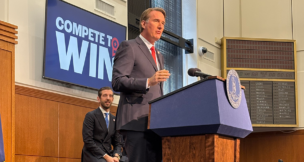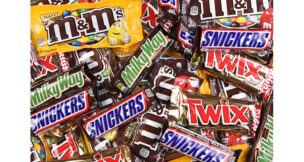
With a slate of major tariff increases, Virginia’s port businesses could be caught in the crosshairs of a global trade war. Photo courtesy Port of Virginia

With a slate of major tariff increases, Virginia’s port businesses could be caught in the crosshairs of a global trade war. Photo courtesy Port of Virginia
Tariffs spark uncertainty for Virginia port and shippers
Jim Morrison //April 30, 2025//
SUMMARY:
-
New tariffs from Trump administration disrupt global shipping and trade.
-
Port of Virginia braces for economic impact amid rising costs.
-
Economists warn prolonged tariffs could trigger statewide job losses.
-
Domestic production efforts face high costs and limited labor supply.
Rachel Shames, vice president for pricing and procurement for Norfolk-based customs broker CV International, has been attending TPM, the California conference for the global container shipping and logistics community, for years. But she’d never experienced a conference like the one in March.
Presenters were changing their slideshows at the last minute, responding to tectonic shifts in the tariffs landscape with announcements from President Donald Trump, who declared import taxes on steel and aluminum, foreign vehicles, pharmaceuticals, copper, lumber and other goods within a matter of weeks.
“The updates were coming in as sessions were underway, in real-time, as news was breaking,” Shames says. “The general mood was frustration and uncertainty.”
Words like “uncertainty” and “moving target” describe the chaotic push and pull of tariff announcements and delays over the first few months of the second Trump administration.
At the start, China, Mexico and Canada were targets. Soon, some of those actions were delayed or changed. Then tariffs on steel and aluminum were announced. The European Union retaliated with tariffs on up to $28 billion worth of American goods, including bourbon, boats and motorcycles. In response, Trump threatened a 200% tariff on all EU countries’ wine.
In early April, Trump rolled out 10% tariffs on imports from all countries, plus higher tariffs on other nations, led by a 34% tax on Chinese imports, 32% on Taiwan, 25% on South Korea, 24% on Japan and 20% on the European Union.
It’s hard to know where prices will end up. The conservative-leaning Tax Foundation in March estimated that the tariffs could affect more than $1 trillion in imports.
“There very likely will be an impact,” says Shames, who works closely with international shippers. “We know when something is tariffed, when something is taxed, there’s usually less that’s moving commercially. We have to expect that’s going to be the overall effect.”
Chinese impact
For the Port of Virginia, the focus is China, a key partner, while Canada, Mexico and, to some extent, Europe, lag behind in trading. The port’s 2024 report shows China as its top import partner and the second-ranked export partner. India tops the list of exports and is second in imports.
The Port of Virginia ranks sixth in the nation for shipping traffic, processing 3.5 million 20-foot equivalent units (TEUs) in fiscal 2024, a 2% increase over the previous year and its second-best performance in its history. The impact of tariffs on the port depends on several factors: the tariffs’ duration, affected commodities and severity of retaliatory tariffs.
Robert McNab, chair of Old Dominion University’s economic department and director of the Dragas Center for Economic Analysis and Policy, says that if tariffs last a month, they would have minimal impact on the state’s economy, but if they linger for a year or more, the consequences throughout the commonwealth could be substantial.
“The effects of tariffs are cascading,” he says. “As tariffs gain momentum and the negative economic impacts aggregate, the job losses accumulate and increase over time. And it’s not just the direct jobs at the port that would be lost.”
Demand for longshoremen, transport drivers, and other landside support like warehousing would decline. Those people would spend less money.
In a worst-case scenario, long-term tariffs on imports and exports would have a cascading effect, accumulating downstream across the economy, McNab says.
Virginia has leaned into becoming a value-added state, bringing in intermediate goods like steel and aluminum that are used in finished goods like cars and appliances and then exported. If prices for those intermediate goods rose, for instance, demand for them would shrink. Those companies would lay off employees.
“That’s the worst-case scenario,” McNab says. “We have a long set of tariffs. We don’t have the domestic capacity to replace those goods at a cheaper cost, and you end up with higher prices. You end up with fewer people who are employed at the port and throughout Virginia because of the negative impacts of tariffs.”
Couple that with reductions in federal employment, and the outlook grows even dimmer.
“Over the last decade, Hampton Roads has been able to rely on increasing defense expenditures and rising levels of federal civilian employment to offset uncertainty with regards to international trade and other economic conditions,” he says. “We could now foresee an environment where tariffs reduce the flow of international trade while federal civilian employment in the region also declines. That could exacerbate the regional and statewide impact.”
That, McNab says, would squeeze economic growth throughout the urban crescent of Hampton Roads, Richmond and Northern Virginia, where 70% of Virginians live.
“If there was a worst-case scenario, it would be prolonged tariffs, declines in federal civilian employment and declining international migration,” McNab added. “Hopefully we don’t end up there, but you could see how these three threads could come together and really push against economic growth in the commonwealth.”
Looking back
However, the state can look to its recent past for some answers. In 2018, Trump imposed higher taxes on Chinese goods, targeting $250 billion in Chinese imports, starting at 10% and rising to 25%. Virginia’s exports to China fell from $1.7 billion in 2017 to $1.2 billion in 2018 and 2019, but China remained the state’s No. 1 source for imports throughout the trade war.
In 2020, a new agreement between the two countries required China to purchase $200 billion more in U.S. exports, bringing Virginia’s exports to China up to $1.8 billion.
Still, there were negative impacts of the first tariff war. A 2020 Brookings report said the tariffs cost American companies $46 billion. Among the most affected was the agriculture industry.
“Farmers have lost the vast majority of what was once a $24 billion market in China” as a result of Chinese retaliatory actions, according to the American Farm Bureau.
Those threats to farmers are back. In March, China levied tariffs ranging from 10% to 15% on products like corn, pork, soybeans and fruit. Oil, seeds and nuts are the second largest export from the Port of Virginia, with wood and wood pulp in the top five. For Virginia farmers and timber harvesters, China was their top customer in 2023, according to the Virginia Department of Agriculture and Consumer Services, importing more than $3.6 billion in agricultural and forestry purchases that year.
While the tariffs on Mexico and Canada splashed across headlines, they have less impact on the port because it does almost no business with those countries, a fraction of 1% of volume, according to Ricardo Ungo, director of ODU’s Maritime, Ports and Logistics Management Institute.
That’s not to say Virginia as a whole won’t be affected by a trade war with Canada, because in 2024, Canada was Virginia’s largest export market, accounting for 15% of exports, according to U.S. Sen. Tim Kaine.
But Ungo points out that after the 2018 Chinese tariffs, overall traffic at the port didn’t suffer. “What I saw for the 2018, 2019 aggregate volume, we didn’t see a real impact for all countries, but you could see impacts specifically for the Chinese items,” he says. “Traffic with China slipped 16% in 2019.
“To see the effects, you have to drill into the specifics of commodities from China. Motor parts decreased 7%. Furniture imports declined about 35%,” he notes. “But overall imports of furniture, which was third on the 2023 report, were compensated by increases from other countries, including Malaysia and Vietnam.”
However, nearly 80% of toys, smartphones, lithium-ion batteries and portable computers come from China, although trade has diversified somewhat in recent years.
“China is still so dominant in a lot of different industries because of the high level of efficiency, the highly skilled labor force,” Shames says, adding that the country has a robust infrastructure as well. “All of the things you’re looking for when you’re when you’re looking to minimize cost but be able to source a quality product.”
The United States — and Virginia — was resilient during the 2018 tariff war because of supply chains created with other exporters, notably in Southeast Asia, but the labor pool is not as large, skilled or efficient as it is in China, experts say.
What’s different today, Shames says, is that the low-hanging fruit has been harvested, and those relationships with other countries are already in place.
“What’s left when we’re looking at China right now is the products that are going to be really hard to move,” Shames says. Also, it’s risky to invest in production elsewhere in an uncertain tariff climate, she adds.

Domestic production
And although the U.S. has made significant moves to increase domestic manufacturing, it can be expensive to jumpstart production.
In Virginia, Microporous is building a $1.35 billion lithium-ion battery component plant in Pittsylvania County, and Micron Technologies is expanding its presence in Manassas to build a $2.17 billion DRAM chip facility, moving its production from Taiwan to Virginia. In Petersburg, a regional pharmaceutical hub has started production, but all three projects are doing so with the assistance of now-unsure federal funding, along with significant investments by their companies and the state.
Shames notes that the U.S. has a smaller skilled labor force for factory jobs, as well as higher wages compared to workers in other countries, which present challenges for companies.
“Certainly there’s room for some manufacturing to come back here,” Shames says. “But whether it’s a very significant portion, I think most in the industry believe that that’s just not going to be possible.”
It’s not yet clear how much impact tariffs could have on Virginia’s manufacturing industry, and Virginia Tech associate professor David Bieri, an economist, said in March that Trump’s tariffs as currently structured won’t “lead to a tremendous amount of job creation in the United States.” McNab anticipates some businesses may freeze hiring or lay off employees out of concern of higher production costs.
And meanwhile, the port is also eyeing the White House proposal to impose levies as high as $1.5 million on Chinese-built ships arriving at American ports, as well as other countries’ vessels that are operated by carriers with Chinese ships in their fleets. The cost could approach $1 million per port call, and Shames says the domestic shipping industry is fighting the plan, which started under former President Joe Biden and is still alive under Trump.
In March, Atlantic Container Line CEO Andrew Abbott told CNBC that this tax would cause his company to go out of business because of costs he would have to pass along to customers, although some larger ocean liners could handle the impact better.
On the surface, Trump says these taxes would lead to more American-made container ships, but that industry has disappeared domestically due to Chinese competition.
“If [the tax] gets implemented, that’s big,” Shames says. “This will have ripple effects with the entire industry, and it will mean that shipping costs go extremely high,” she says, adding that it will eliminate some port calls because of the cost.
“Most people in our industry are optimistic that that proposal will not be implemented. If it is, it will be at a completely different level of congestion and freight pricing that we may have never seen before.”
Once again, it’s one more instance of uncertainty for an industry that has been impacted by the pandemic, geopolitical warfare and inflation over the past five years.
“You want to have some kind of a plan to counteract whatever kind of challenge you’re up against, some sort of a solution that will help you avoid, or at least minimize the impacts of something like this,” Shames says. “The problem is shippers really don’t know what next steps to take.”
g















